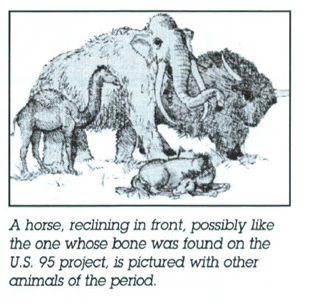
ITD From the Vault: 20 Years Ago
Fossilized bone of ancient horse found in US-95 project pit
A fossilized bone, believed to be the bone of a horse dating from between 1.5 million and 8 million years ago, has been found near a transportation department project to reconstruct more than six miles of US-95 near Fruitland and Parma.![]()
The bone was found last weekend by a neighbor at a privately owned sand and gravel pit that prime contractor Steelman-Duff Inc. of Clarkston, Wash., is using for this $5.6 million project. As luck would have it, District 3's Bill Nance who is the acting project coordinator for the U.S. 95 reconstruction is also an archaeologist and a curator for the Museum of Natural History at Albertson College of Idaho in Caldwell.
Nance examined the gravel pit and determined that the fossil was an isolated bone in a sand pocket, and not part of a bone bed. Had an entire skeleton been found, the contractor would have had to work at a different end of the pit. The find, although fascinating, will not halt operations on the highway project.
According to Transportation Archaeologist Jenna Gaston, vertebrate fossils are not unusual in southwest Idaho. Fossils are fairly common in gravel formations along the Snake River, from Adrian, Ore. to Weiser, within gravel beds on both sides of the river. Animal bones were often transported by water and frequently turn up in old sand deposits from lakes or rivers.
often transported by water and frequently turn up in old sand deposits from lakes or rivers.
In addition to horses, bones from camels and elephants have been found in Idaho. In fact, horses are native to Idaho and later crossed into Asia.
The bone that was found is mineralized, with the section where the marrow would be now replaced by stone. It's about a foot long and broken off at one end. lt's about 4.5 inches wide at the top and about 2 inches wide where it's broken.
Nance has tentatively identified the fossil as a horse bone, although large to be a horse and too small to be an elephant. Dr. Greg McDonald, chief research paleontologist from the Hagerman Fossil Bed National Monument will give the bone a positive identification at a special workshop he's conducting at Albertson College. Nance is anxious for McDonald's analysis, thinking that this fossil might represent a new species.
Published 10-26-18